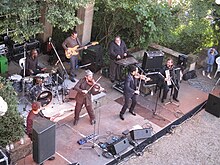로데
Lode지질학에서 광맥은 암석층 사이에 퇴적 또는 매설된 광맥이나 암석 [1]형성의 균열(또는 균열)에 채워지거나 박혀 있는 금속광의 퇴적물이다.현재의 의미(오레맥)는 17세기부터 시작되었는데, 이는 중세 후기 영어에서 "채널, 물길"에 대한 초기의 의미를 확장한 것이며, 이는 다시 11세기 광맥이 "코스, 길"[2]이라는 뜻에서 유래했다.
일반적으로 받아들여지고 있는 열수성 광상 모델에서는 열수성 용액(온천액)에 용해된 금속이 기존의 [3]암석에 있는 틈새 안에 금 또는 다른 금속 광물을 퇴적시킨다고 가정합니다.광맥 퇴적물은 주로 광석이 원래의 퇴적 환경에서 침식되어 [4]퇴적물에 의해 재침적된 사광 퇴적물과 구별됩니다.광석 증착의 세 번째 공정은 증발광이다.
스트링거 광맥은 작은 광맥에 의해 암석이 스며들어 광맥을 채굴하는 대신 광석 전체와 에반토 지방의 암석을 채굴하는 광맥을 말한다.광석이 시골 암석과 [5]분리되지 않도록 정맥이 불규칙하게 갈라져 많은 문합 현수막으로 만들어졌기 때문에 붙여진 이름이다.
가장 큰 은빛 광맥 중 하나는 [6]네바다주에 있는 컴스톡 광맥이었지만,[7][8] 호주 퀸즐랜드에서 최근에 발견된 캐닝턴 광맥에 가려져 있었다.미국에서 가장 큰 금광맥은 홈스테이크 [9]광맥이었다.사우스 오스트레일리아에 있는 브로큰 힐 로드는 지금까지 발견된 [10]것 중 가장 큰 납-아연 광맥입니다.
「 」를 참조해 주세요.
메모들
- ^ Thompson, Joseph Wesley (1913). "Lode Locations". Abstracts of Current Decisions on Mines and Mining, March to December, 1914. Bulletin 79, Law Serial 2. Bureau of Mines, U.S. Department of the Interior. p. 13. OCLC 29112728.
- ^ a b "lode". Oxford English Dictionary (Online ed.). Oxford University Press. (가입 또는 참여기관 회원가입 필요)
- ^ Fournier, R.O. (1999). "Hydrothermal processes related to movement of fluid from plastic into brittle rock in the magmatic environment". Economic Geology and the Society of Economic Geologists. 18: 486–497.
- ^ McGregor, Tisha; et al. (2000). "Mining the Motherlode: Lode vs. Placer Mining". Wells, California: Wells Historical Society. Archived from the original on 29 May 2002.
- ^ Wood, George McLane, ed. (1916). Suggestions to authors of papers submitted for publication by the United States Geological Survey with directions to typewriter operators. Washington, DC: United States Geological Survey. p. 35. OCLC 7678360.
- ^ Smith, Grant Horace (1943). The History Of The Comstock Lode. Reno, Nevada: Nevada State Bureau of Mines and the Mackay School of Mines. OCLC 3145590.
- ^ Staff (2007). "Cannington Silver and Lead Mine, Queensland, Australia". Mining-technology.com of Net Resources International. Archived from the original on 31 December 2007.
- ^ Walters, Stephen; Bailey, Andrew (1998). "Geology and mineralization of the Cannington Ag-Pb-Zn deposit; an example of Broken Hill-type mineralization in the eastern succession, Mount Isa Inlier, Australia". Economic Geology. 93 (8): 1307–1329. doi:10.2113/gsecongeo.93.8.1307.
- ^ Yarrow, Andrew L. (9 August 1987). "Beneath South Dakota's Black Hills". The New York Times. Retrieved 2008-01-11.
Homestake, which is the largest, deepest and most productive gold mine in North America, has yielded more than $1 billion in gold over the years.
- ^ Staff (February 2007). "Curnamona Geology". Department for Manufacturing, Innovation, Trade, Resources and Energy, Government of South Australia.
- ^ 뉴옥스포드 아메리칸 딕셔너리(NOAD), 제3판.



